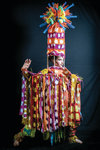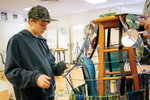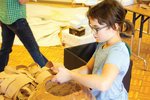When Caden Grant unveils his latest creation on the catwalk during the Wearable Art Show May 11, his inner creativity will be on full display.
Grant, a Quilcene 8th grader, is putting the finishing touches on a jellyfish costume decorated with dozens of donated CDs.
This item is available in full to subscribers.
We have recently launched a new and improved website. To continue reading, you will need to either log into your subscriber account, or purchase a new subscription.
If you had an active account on our previous website, then you have an account here. Simply reset your password to regain access to your account.
If you did not have an account on our previous website, but are a current print subscriber, click here to set up your website account.
Otherwise, click here to view your options for subscribing.
* Having trouble? Call our circulation department at 360-385-2900, or email our support.
Please log in to continue |
|



When Caden Grant unveils his latest creation on the catwalk during the Wearable Art Show May 11, his inner creativity will be on full display.
Grant, a Quilcene 8th grader, is putting the finishing touches on a jellyfish costume decorated with dozens of donated CDs.
“This piece is very complicated,” said Camille Hildebrandt, Quilcene Schools performing arts teacher and wearable art coordinator. “It is actually engineering.”
All the weight of the costume rests on Grant’s head, where it is connected to a modified bicycle helmet he wears.
“It has to go on and off his body three times because there is a dress rehearsal, there is a matinee performance and it has to survive, so it has to be something that is sturdy,” Hildebrandt said. “That is critical thinking.”
The idea came from a 2D drawing Grant made before translating the costume into the 3D realm.
“It is from their imagination. Something is internal and intuitive being brought into the world that never existed before,” Hildebrandt said. “I have never seen a jellyfish that was made out of CDs.”
A group of adult artists have been mentoring the half-dozen students crafting costumes for the show, Hildebrandt said.
Amy Grondin has been working with Grant.
“It is all his vision,” she said. “I am just trying to help him figure it out.”
Grondin is part of an all-volunteer group of artists dubbed the SWATCH Team that commutes from Port Townsend to Quilcene every Friday to help the student designers get their wearable art pieces ready for the runway.
“They have to collaborate with their mentors and with each other,” Hildebrandt said. “How is this thing going to stay on her body? How is this going to look like something that is not actually a lampshade?”
The SWATCH team includes Judith Bird, Maggie Day, Grondin, Margie McDonald and Kim Nunes.
The students will compete side-by-side with more than 30 adult artists at the Port Townsend Wearable Art show for a best-in-show prize of $2,500.
There is also a $250 first prize for best student work, and a SWATCH-sponsored second and third prize for students in the amounts of $100 and $50, respectively.
The show, now in its ninth year, is the sole fundraiser for the Jefferson Community Foundation’s Fund for Women & Girls.
Hildebrandt spearheaded the after-school design sessions when a brief daytime enrichment session took on a life of its own.
“In arts education, we teach skills that are necessary to succeed in the 21st century,” Hildebrandt said. “Creating a runway-ready piece requires an active imagination, the ability to communicate a creative vision to peers as well as an audience, and the ability to collaborate with the professional artists who are serving as their mentors. Wearable Art brings it all together.”
Helping hands
Anna Munn was inspired by Pisces, her birth sign. “I have always liked art,” said the Quilcene School District 6th grader. “and I thought it would be fun to make an actual big huge piece.”
Munn’s creation includes the planets Jupiter and Neptune, and the Constellation Pisces, which lights up on the black gown. She said SWATCH mentors helped her move from concept to design to completed project.
“They really help,” she said. My piece was very hard to do, then we turned it into how it is now, functional.”
Munn is feeling the stress as she approaches the deadline to complete the project, but overall is excited to participate in the wearable art show.
McDonald said the SWATCH Team volunteers relish the opportunity to guide emerging artists.
“It has been fantastic because they are all so dedicated to making these pieces happen,” McDonald said. “They all come in and work really hard, and so it is fun to see what they are doing. It is also fun to see them do a two-dimensional piece on paper (and) how it translates to three dimensions.”
That process involves a large amount of problem-solving and flexibility when a design as originally planned doesn’t work, McDonald said.
“You’ve got to be open to being able to change, and that is what we are seeing these students do.”
As the projects get nearer to completion, McDonald said she has seen the students’ confidence increase exponentially.
“They are getting more and more firm about the idea of what they are making.”
And while the design process is highly enjoyable, McDonald said she is looking forward to the accolades the students will receive when the get on the runway.
“My favorite thing is when we see them on the stage, and how they transform when they get in front of that giant audience and what that does for their self-esteem and their confidence is fantastic.”
That moment has a tremendous impact on the self-esteem of the youths involved, McDonald said. “If you are able to do that when you are 12 or 13, imagine what you could do as an adult.”
McDonald also teaches Wearable Art Camp at the Port Townsend School of the Arts during the summer.
One of her past students, Nadia Fisch, completed a design at camp that went on to win Best in Show at the Port Townsend Wearable Art Show last year.
“I love seeing the students transform over the years, growing in confidence and skills.”
Hildebrandt said she loves how the professional artists have been respectful of each student’s vision.
Fisch, of Port Townsend, currently is in seventh grade and will compete again this year.
Other student designers from outside Quilcene include Isabella Nunn, Macyn Little, Cyan Adams, Sara and Taryn of Port Townsend, Una McFaddin of Portland, Oregon and Chiara Jane Kozlovich of El Prado, New Mexico.
Hand picked mentors
McDonald chose the SWATCH Team members because they love wearable art and have a wide range of skills to offer, she said.
“They wisely ask questions and support a student’s ideas with real world knowledge, such as what gauge wire would work to hold something together, or what kind of yarn would give an ethereal effect.”
The artists even collect materials for the students to use, Hildebrandt said.
“This is hands-on learning at its best.”
Beyond watching the students grow and learn, the most exciting aspect of the process is seeing the final results of the projects come forth, Hildebrandt said.
“They are all incredibly different and that is because they came from each individual’s imagination.”